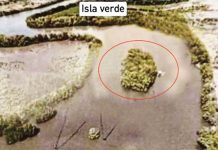
ILOILO City – The Philippine Institute of Volcanology and Seismology (Phivolcs) has recorded “weak ash emissions” from Mount Kanlaon, heightening concerns over the ongoing volcanic activity on Negros Island.
Time-lapse footage from Phivolcs cameras shows several instances of ash release from the summit crater, with emissions documented on April 1 and 2.
The ash plumes, ranging from 100 to 400 meters above the crater, were observed at 12:58 p.m. and 11:14 p.m. on April 1, followed by emissions at 2:15 a.m., 2:52 a.m., 5:04 a.m., 7:26 a.m., and 8:26 a.m. on April 2.
These events lasted anywhere from three to 77 minutes, with the ash drifting westward as captured by Phivolcs’ IP cameras in Canlaon City and Mansalanao, La Castellana.
While the emissions were classified as weak, they led to light ashfall in affected areas.
Reports of ashfall and sulfur odors came from Sitio Guintubdan, Barangay Ara-al, La Carlota City, and several parts of Bago City, including Barangay Binubuhan (Purok Orchids and Yellowbell), Ilijan, Maao, and Mailum.
Phivolcs first raised Mount Kanlaon’s alert status to Level 3 following an explosive eruption on December 9, 2024. This raised alarm due to the potential for additional short-lived explosive eruptions, which could lead to the generation of dangerous pyroclastic density currents (PDCs) within a 6-kilometer radius of the summit.
Authorities are urging immediate action, advising communities within the 6-kilometer radius to evacuate due to the ongoing risk of lava flows, rockfalls, and pyroclastic density currents.
Civil aviation authorities have also been alerted to prevent flights near the summit, as the ash could pose a significant threat to aircraft.
Kanlaon has been exhibiting continuous seismic activity since June 2024, and while the volcano remained under Alert Level 2 until December 2025, the upgrade to Level 3 marks a shift towards magmatic unrest.
Phivolcs has confirmed that a magmatic eruption has commenced, which could lead to more explosive eruptions in the short term.
Kanlaon, a stratovolcano standing at 2,465 meters above sea level, straddles the provinces of Negros Occidental and Negros Oriental. Known as the highest peak in the Visayas, it is part of the Pacific Ring of Fire and one of the most active volcanoes in the Philippines.
Kanlaon has over 30 recorded eruptions since 1819. Its most violent eruption in recent history occurred in August 1996, when a sudden explosion killed three climbers and injured 18 others.
During its eruption on December 9, 2024 at 3:03 p.m., Kanlaon released a massive ash plume and triggering pyroclastic flows./PN





